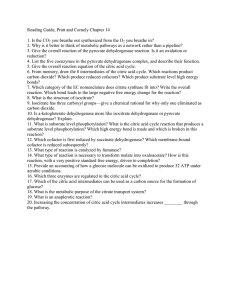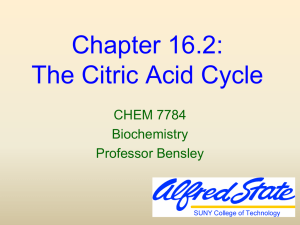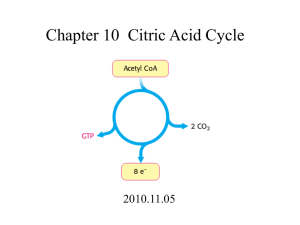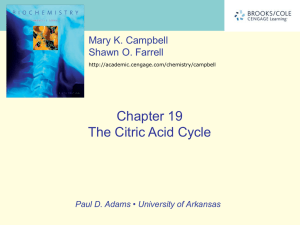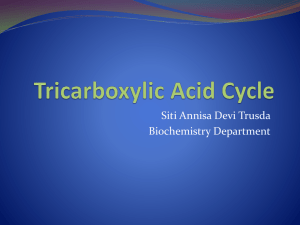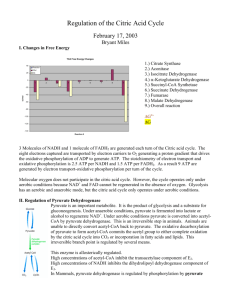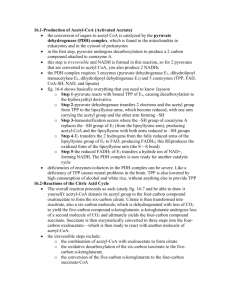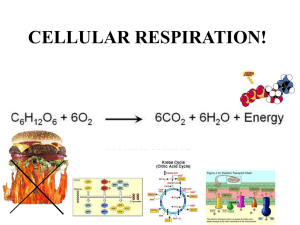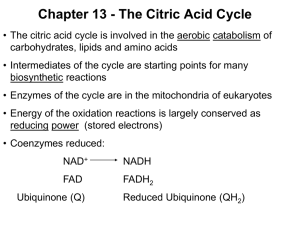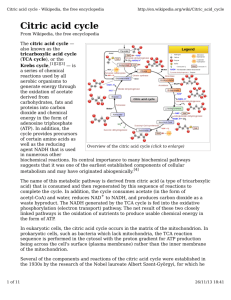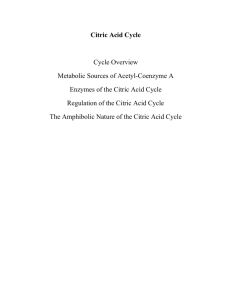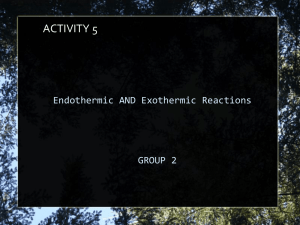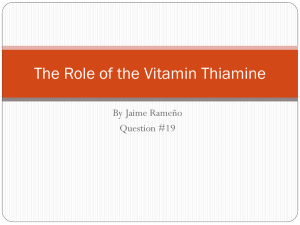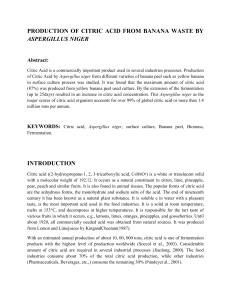16.3 Regulation of the Citric Acid Cycle
advertisement
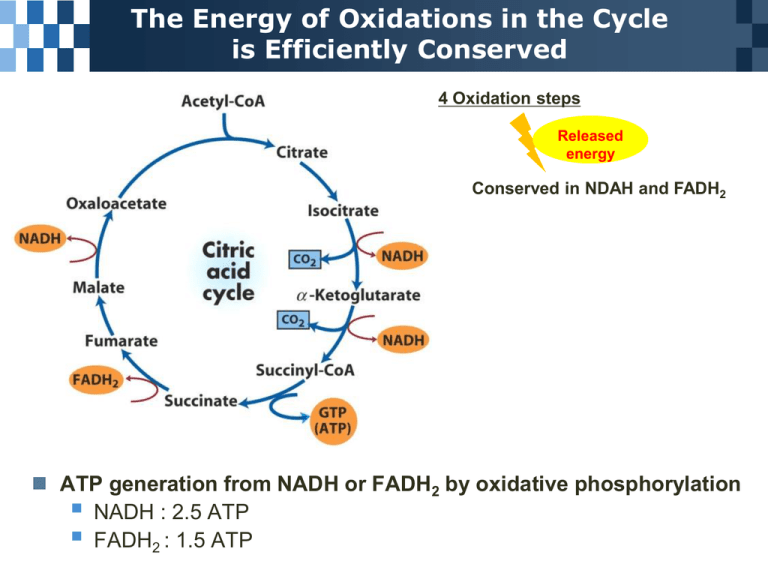
The Energy of Oxidations in the Cycle is Efficiently Conserved 4 Oxidation steps Released energy Conserved in NDAH and FADH2 ATP generation from NADH or FADH2 by oxidative phosphorylation NADH : 2.5 ATP FADH2 : 1.5 ATP The Energy of Oxidations in the Cycle is Efficiently Conserved ATP generation from 1 glucose Total : 30-32 ATP 32 X 30.5 kJ/mol = 976 kJ/mol 34% of the maximum of ~2,840 kJ/mol available from the complete oxidation of glucose 65% efficiency within cells considering DG of ATP hydrolysis Roles of citric acid cycle Oxidation of acetyl group Hub of intermediary metabolism Entry of 4- or 5-C products from catabolic process “fuel” Providing precursors for biosynthesis Incomplete citric acid cycle in anaerobic bacteria Production of biosynthetic precursors Citric acid Cycle for Biosynthesis Amphibolic pathway Anaplerotic Reactions Replenish Citric Acid Cycle Intermediates Anaplerotic Reactions Generation of OAA or malate from pyruvate or PEP Constant maintenance of citric acid cycle intermediates Pyruvate carboxylase in liver and kidney Allosteric stimulation by acetyl-CoA Biotin cofactor PEP carboxylase in plant, yeast, bacteria Activation by Fru 1,6-bisphosphate Biological Tethers Flexible tethers Movement of reaction intermediates from one to another active sites (w/o dissociation) Lipoate Biotin High affinity with avidin in egg white Biotin-avidin interaction Useful researche tools in biochemistry and cell biology Pantothenate 16.3 Regulation of the Citric Acid Cycle - Avoiding wasteful overproduction - Keeping the cell in stable steady state Regulation of the Citric Acid Cycle Regulation of the Citric Acid Cycle 1. Pyruvate dehydrogenase complex rxn 2. Citrate synthase rxn 3. Isocitrate dehydrogenase rxn 4. a-Ketoglutarate dehydrogenase rxn Three factors for the rate of flux through the cycle 1. Substrate availability 2. Inhibition by accumulating products 3. Allosteric feedback inhibition Regulation mechanisms 1. Allosteric regulation 2. Covalent modification Regulation of the Citric Acid Cycle Regulation of PDH Complex in Mammals Allosteric regulation High ratio of [ATP]/[ADP], [NADH]/[NAD+], [acetyl-CoA]/[CoA] Allosteric inhibition Covalent modification (by regulatory kinase & phophatase) Reversible -lation on Ser in E1 High [ATP] allosteric activation of specific kinase inactivation of E1 by -lation Regulation of the Citric Acid Cycle Regulation of 3 exergonic steps Citrate synthase Isocitrate dehydrogenase a-Ketoglutarate dehydrogenase complex Substrate availability ; OAA, acetyl-CoA, NAD+ Feedback inhibition ; succinyl-CoA, citrate, ATP Ca2+ in muscle tissue ; allosteric activation “Substrate Channeling Through Multienzyme Complexes May Occur in the Citric Acid Cycle” Metabolons Multienzyme complexes ensuring efficient passage of the product of one enzyme reaction to the next enzyme substrate channeling In citric acid cycle Associated together as supramolecular complexes Association with the inner mitochondrial membrane 16.4 The Glyoxylate Cycle Glyoxylate Cycle Conversion of acetate to carbohydrate In organisms other than vertebrates Net conversion of acetate to succinate or other 4-C intermediates of citric acid cycle 2 Acetyl-CoA + NAD+ + 2 H2O succinate + 2 CoA + NADH + H+ Enzymes specific for glyoxylate cycle Isocitrate lyase Malate synthase Not in vertebrates Glyoxylate Cycle in Germinating Seeds Glyoxysome (in plant) Specialized peroxisome Organelles containing enzymes for glyoxylate cycle & fatty acid degradation Developed in lipid-rich seeds during germination Regulation of Citric Acid Cycle and Glyoxylate Cycle Regulation of isocitrate dehydrogenase - Isocitrate (sharing common intermediate) - Covalent modification Reversible -lation (specific kinase or phosphatase) Intermediates of citric acid cycle and glycolysis, AMP, ADP Allosteric regulation Activation of isocitrate dehydrogenase via inactivation of specific kinase activation of citric acid cycle Inactivation of isocitrate lyase inhibition of glyoxylate cycle
